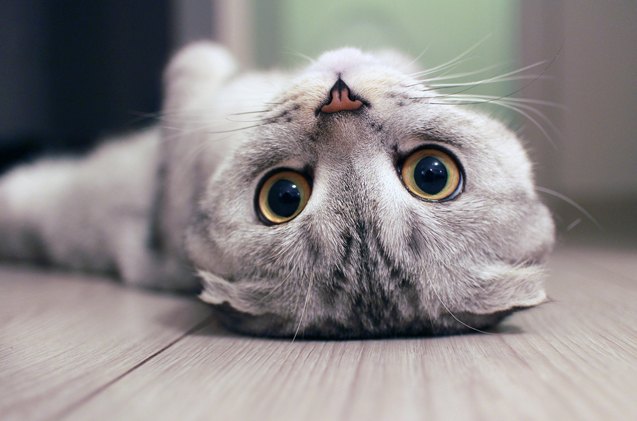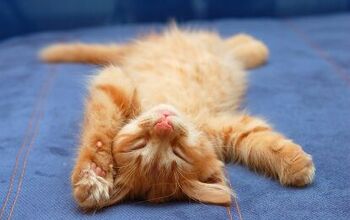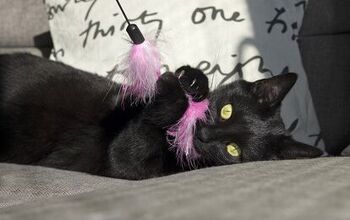Why Are Cats So Protective of Their Bellies?

Have you ever rubbed a cat’s belly? Chances are that if you ever tried, you got a hiss and a paw full of claws for your troubles.
It’s hard to resist petting a super soft cat, and their adorable belly, in particular, might look like the perfect spot to give your kitty some attention. After all, if you’ve met dogs who enjoy having their belly rubbed a lot, you might just assume that it would be the same with cats. The reality, though, is that this isn’t always the case, and you might be surprised by a feline’s reaction even when you’re just putting your hand near this part of their body.
Understanding cats better can help ensure you will be able to give them what they need. But the thing is that, when it comes to petting a kitty’s belly, things can get a bit confusing.
Different Cats Will Have Different Preferences
Some cats will be fine with you rubbing, and even kissing, their belly area. But others will not think twice about making sure you know that the belly is off limits.
This means that, even if you know a cat who lets you pet them however you wish, you should not assume that every other kitty you encounter will feel the same way. It’s really a matter of figuring out what each individual cat prefers.
Related: How to Properly Pet a Cat
Whenever you meet a cat for the first time, it is a good idea to assume that she won’t be too keen on you touching her wherever you want, whether it’s the belly, the head, the tail, or anywhere in between. Approaching a cat slowly and earning her trust is a smart move. From there, you can gradually figure out what she will tolerate when it comes to being petted.
It’s usually wise to assume that a kitty won’t like you going near her belly, especially if she doesn’t know you too well. But why are cats, generally, so protective of their bellies? And how can you know if a kitty will be okay with you touching her in this particular spot? Below is some helpful information that can shed some light on this topic.
The Belly Is a Vulnerable Area
Although cats are incredible predators, they can also be prey, and the stomach is a vulnerable spot because that’s where the vital organs are found. So, when a kitty’s stomach is touched, she may react aggressively because she immediately feels the need to move into self-defense mode. In other words, a cat might just be trying to protect herself. Makes sense, right?
If a kitty doesn’t trust you, she might react by grabbing your hands with her paws, scratching you with her claws, or biting you. Despite this negative reaction, you shouldn’t get angry, as this is a totally normal instinct that your cat uses to protect herself from harm.
On the other hand, if your cat really trusts you and feels completely comfortable around you, she might gladly show off the belly to let you know that she doesn’t feel the need to be protective of it. In that case, you may be able to rub her belly like you would do with a little dog, and it can be a great way to bond with your furry companion.
Related: What Does It Mean When A Cat Wags Its Tail?
Why Would Your Cat Show You Her Belly?
Considering how protective your kitty is over her belly, why would she expose it in the first place?
According to feline behavior expert Pam Johnson-Bennett, when two cats are fighting, one might expose the stomach by rolling onto her side. Even though you might immediately interpret this as an act of submission, the cat is actually telling her adversary that a serious fight will ensue if need be. In this defensive stance, a cat is telling an enemy that the teeth and the claws are ready to be engaged in combat.
On the other hand, if your kitty is lazily stretched out on her back, such as in a sunny area in your home or on your bed, or if she is near you and decides to roll over onto her back, she’s probably totally relaxed and at ease. It’s a sign that she feels safe in her environment and she doesn’t sense any threats to worry about. Good job on giving your pet a home where she can feel like royalty!
But there is something to consider. Sure, your cat might be showing you her fluffy belly, but if you attempt to pet her, she may very well end up reacting defensively anyway. That’s because she might only be telling you that she trusts you, but she still has her boundaries. Again, it is all about figuring out what your unique cat’s preferences are and then working around them to keep her happy and to keep your fingers safe from the wrath of her claws and teeth.
The Bottom Line: Get to Know Your Feline Companion
Every cat is different, so it all boils down to spending time with your pet and getting to know her. You may find that she shows you her belly as a sign of trust rather than an invitation to stroke that delicate area (she might just want her head scratched instead, as an example).
Your cat might even be in a playful mood when she shows you her stomach, so she may end up grabbing your hand gently enough that she won’t hurt you. Or you might have formed such a strong bond with your cat that she trusts you 100% and is willing to let you pet her belly, rest your hand on her tummy, or even give her kisses on her stomach.
Also, it may be more likely that an adult cat will be okay with belly rubs if she got used to them while she was a kitten. After all, kittens and young cats can develop preferences and establish comfort levels based on the interactions that they experience while growing. This is why it’s best to spend a lot of time interacting with your new pet and showing her loads of affection. That way, you can get to know each other, as well as help her feel at ease by teaching her that she’s safe around you.
There you have it: another mysterious and confusing feline behavior solved. Remember, it’s all about learning how to read your cat’s body language so you can avoid getting scratched or bitten when that cute tummy is exposed.

Lisa Selvaggio is a freelance writer and editor, and our resident cats-pert, with certifications in pet nutrition and pet first aid. She enjoys producing content that helps people understand animals better so they can give their pets a safe and happy home.
More by Lisa Selvaggio






















